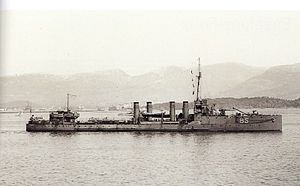Bisson-class destroyer

A profile view of Bisson in harbor
|
|
| Class overview | |
|---|---|
| Name: | Bisson class |
| Operators: |
|
| Preceded by: | Bouclier class |
| Succeeded by: | Enseigne Roux class |
| Built: | 1911–14 |
| In commission: | 1912–34 |
| Completed: | 6 |
| Lost: | 1 |
| Scrapped: | 5 |
| General characteristics | |
| Type: | Destroyer |
| Displacement: | 768–804 t (756–791 long tons) |
| Length: | 78.1 m (256 ft 3 in) (p/p) |
| Beam: | 8.6 m (28 ft 3 in) |
| Draft: | 3.1 m (10 ft 2 in) |
| Installed power: |
|
| Propulsion: | 2 shafts; 2 Steam turbines |
| Speed: | 30 knots (56 km/h; 35 mph) |
| Range: | 1,950 nmi (3,610 km; 2,240 mi) at 14 knots (26 km/h; 16 mph) |
| Complement: | 80–83 |
| Armament: |
|
The Bisson class was a group of six destroyers built for the French Navy during the 1910s. One ship was lost during the First World War, but the others survived to be scrapped afterwards.
The class is named in tribute to the French Admiral who sacrificed himself aboard the ship Panayoti in 1827 during the Greek War of Independence.
The class carried the same armament of two 100 mm (3.9 in) guns, four 65 mm (2.6 in) guns and four 450 mm (18 in) torpedo tubes in two trainable mounts as the preceding Bouclier class, while steam turbines delivered 15,000 shaft horsepower (11,000 kW) giving a speed of over 30 knots (56 km/h) (Magnon reached 32.02 knots (59.30 km/h; 36.85 mph) during sea trials, the fastest of the class).
They were laid down between 1911 and 1912 and launched from 1913 from 1914. The class served primarily in the Mediterranean Sea during the First World War, with Bisson sinking the Austrian submarine U-3 on 13 August 1915, with Renaudin being sunk by U-6.
...
Wikipedia
